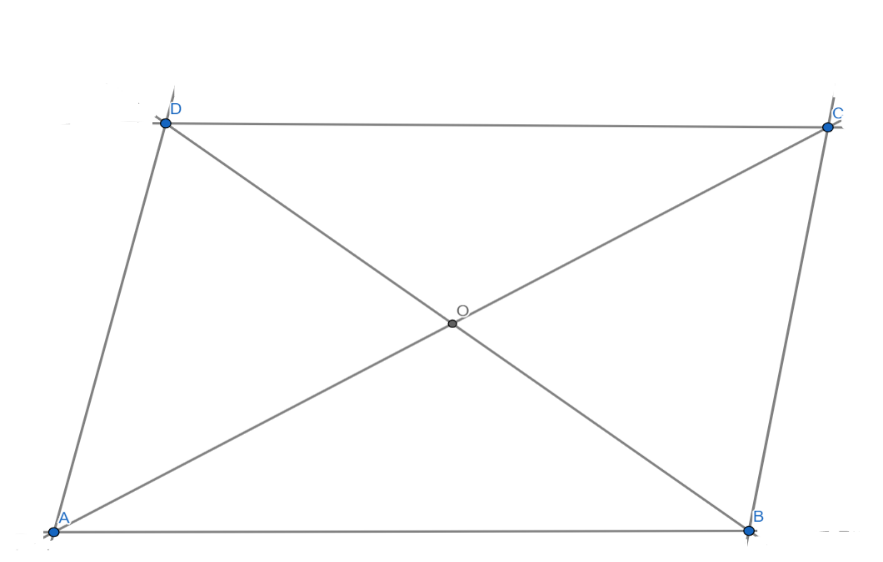
The three vertices of a parallelogram $ABCD$ are $A(3,-4),B(-1,-3)$ and $C(-6,2)$. Find the coordinates of vertex $D$ and find the area of $ABCD$.
Answer
569.1k+ views
Hint: We are given the three vertices of a parallelogram $ABCD$ are $A(3,-4),B(-1,-3)$ and $C(-6,2)$. By using midpoint $O$ find vertex $D$. After that, to find the area used, Area of parallelogram $ABCD$ $=$ Area of $\Delta ABC$ $+$ Area $\Delta ADC$.
Complete step-by-step answer:

Now we are given the three vertices of a parallelogram $ABCD$ are $A(3,-4),B(-1,-3)$ and $C(-6,2)$.
$O$ is midpoint of $AC$$=(\dfrac{3-6}{2},\dfrac{-4+2}{2})$
Simplifying we get,
$O$ is midpoint of $AC$$=(\dfrac{-3}{2},-1)$ ……… (1)
In similar way,
$O$ is the midpoint of $BD$$=(\dfrac{-1+a}{2},\dfrac{-3+b}{2})$ …………. (2)
Now equating (1) and (2), we get,
$(\dfrac{-3}{2},-1)=(\dfrac{-1+a}{2},\dfrac{-3+b}{2})$
So, $-\dfrac{3}{2}=\dfrac{-1+a}{2}$
$a=-2$
Now, $\dfrac{-3+b}{2}=-1$
$b=1$
Therefore, $D(-2,1)$.
Now,
Area of parallelogram $ABCD$ $=$ Area of $\Delta ABC$ $+$ Area $\Delta ADC$
Area of parallelogram $ABCD$ $=$ $2$Area of $\Delta ABC$
Let us find Area of $\Delta ABC$ ,
Area of $\Delta ABC$ $=\dfrac{1}{2}[{{x}_{1}}({{y}_{2}}-{{y}_{3}})+{{x}_{2}}({{y}_{3}}-{{y}_{1}})+{{x}_{3}}({{y}_{1}}-{{y}_{2}})]$
Area of $\Delta ABC$ \[=\dfrac{1}{2}[3(1-2)-2(2+4)-6(-4-1)]\]
Simplifying we get,
Area of $\Delta ABC$ \[=\dfrac{15}{2}\]sq. units
So now,
Area of parallelogram $ABCD$ $=$ $2$Area of $\Delta ABC$$=2\times \dfrac{15}{2}=15$ sq. units
Therefore, the area of parallelogram is $15$ square. units.
Additional information:
A parallelogram is a two-dimensional geometrical shape, whose sides are parallel with each other. It is a polygon having four sides, where the pair of parallel sides are equal in length. Also, the interior opposite angles of a parallelogram are equal to each other. The area of parallelogram depends on the base and height of it. A parallelogram is a quadrilateral with two pairs of parallel sides. The opposite sides of a parallelogram are equal in length, and the opposite angles are equal in measure. Also, the interior angles on the same side of the transversal are supplementary.
Note: A square and a rectangle are two shapes which have similar properties of a parallelogram. The opposite sides of a parallelogram are equal in length, and the opposite angles are equal in measure. The area of a parallelogram is the region bounded by the parallelogram in a given two-dimension space. To recall, a parallelogram is a special type of quadrilateral which has four sides, and the pair of opposite sides are parallel.
Complete step-by-step answer:

Now we are given the three vertices of a parallelogram $ABCD$ are $A(3,-4),B(-1,-3)$ and $C(-6,2)$.
$O$ is midpoint of $AC$$=(\dfrac{3-6}{2},\dfrac{-4+2}{2})$
Simplifying we get,
$O$ is midpoint of $AC$$=(\dfrac{-3}{2},-1)$ ……… (1)
In similar way,
$O$ is the midpoint of $BD$$=(\dfrac{-1+a}{2},\dfrac{-3+b}{2})$ …………. (2)
Now equating (1) and (2), we get,
$(\dfrac{-3}{2},-1)=(\dfrac{-1+a}{2},\dfrac{-3+b}{2})$
So, $-\dfrac{3}{2}=\dfrac{-1+a}{2}$
$a=-2$
Now, $\dfrac{-3+b}{2}=-1$
$b=1$
Therefore, $D(-2,1)$.
Now,
Area of parallelogram $ABCD$ $=$ Area of $\Delta ABC$ $+$ Area $\Delta ADC$
Area of parallelogram $ABCD$ $=$ $2$Area of $\Delta ABC$
Let us find Area of $\Delta ABC$ ,
Area of $\Delta ABC$ $=\dfrac{1}{2}[{{x}_{1}}({{y}_{2}}-{{y}_{3}})+{{x}_{2}}({{y}_{3}}-{{y}_{1}})+{{x}_{3}}({{y}_{1}}-{{y}_{2}})]$
Area of $\Delta ABC$ \[=\dfrac{1}{2}[3(1-2)-2(2+4)-6(-4-1)]\]
Simplifying we get,
Area of $\Delta ABC$ \[=\dfrac{15}{2}\]sq. units
So now,
Area of parallelogram $ABCD$ $=$ $2$Area of $\Delta ABC$$=2\times \dfrac{15}{2}=15$ sq. units
Therefore, the area of parallelogram is $15$ square. units.
Additional information:
A parallelogram is a two-dimensional geometrical shape, whose sides are parallel with each other. It is a polygon having four sides, where the pair of parallel sides are equal in length. Also, the interior opposite angles of a parallelogram are equal to each other. The area of parallelogram depends on the base and height of it. A parallelogram is a quadrilateral with two pairs of parallel sides. The opposite sides of a parallelogram are equal in length, and the opposite angles are equal in measure. Also, the interior angles on the same side of the transversal are supplementary.
Note: A square and a rectangle are two shapes which have similar properties of a parallelogram. The opposite sides of a parallelogram are equal in length, and the opposite angles are equal in measure. The area of a parallelogram is the region bounded by the parallelogram in a given two-dimension space. To recall, a parallelogram is a special type of quadrilateral which has four sides, and the pair of opposite sides are parallel.
Recently Updated Pages
Master Class 9 Social Science: Engaging Questions & Answers for Success

Master Class 9 Science: Engaging Questions & Answers for Success

Master Class 9 English: Engaging Questions & Answers for Success

Master Class 9 Maths: Engaging Questions & Answers for Success

Master Class 9 General Knowledge: Engaging Questions & Answers for Success

Class 9 Question and Answer - Your Ultimate Solutions Guide

Trending doubts
Which places in India experience sunrise first and class 9 social science CBSE

Fill the blanks with the suitable prepositions 1 The class 9 english CBSE

Write the 6 fundamental rights of India and explain in detail

Difference Between Plant Cell and Animal Cell

What is pollution? How many types of pollution? Define it

What is the Full Form of ISI and RAW




